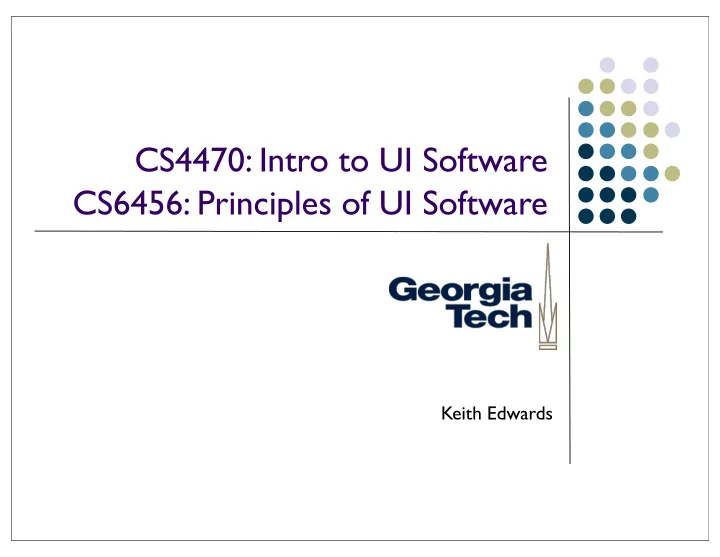

CS4470: Intro to UI Software CS6456: Principles of UI Software Keith Edwards
Today’s Agenda Introductions Me TAs You Class Overview Syllabus Resources Class Policies 2
Introductions Instructor Keith Edwards TSRB 345 good: keith@cc.gatech.edu bad: 404-385-6783 HCI Technical side of HCI UI infrastructures Ubicomp Making security, networking more usable 3
Introductions TA 4
Now, It’s Your Turn Name (pronunciation if non-obvious) Major, Year Interests Why UI SW? 5
What is this class about? Organizing principles of UI software Practice in UI implementation (lots) Part I: Basics of traditional 2-dimensional GUIs Part II: Advanced topics (animation, audio, etc.) 6
What this class is NOT about User-centered design That’s what 4750/6750 are for! 7
Basic Course Info “Prerequisite”: CS4750/6750 Remedial background texts: “Human-Computer Interaction,” Dix, Finlay, Abowd, Beale “The Design of Everyday Things,” Norman Web materials Up now: See CoC website for link General info (books/readings, exams, homework) Syllabus Will be updated throughout the semester Will contain links to lecture slides 8
Resources Recommended: Java Swing, Second Edition Loy, Eckstein, Wood, Elliott, Cole O’Reilly Associates Helpful for the Swing-based programming assignments Recommended and Free! Java AWT Reference Zukowski O’Reilly Associates Somewhat out-of-date, but downloadable! http://www.oreilly.com/catalog/javawt/book/index.html AWT is the layer “underneath” Swing 9
Grading Criteria Different criteria for undergrad versus grad First half of semester: Everyone: 3 individual homework assignments (3 x 10%) Exam 1 (20%) Second half of semester: Undergrads: 3 individual homework assignments (3 x 10%) Grads: Research project (30%) -- two person teams Writing, implementation, presentation Everyone: Final exam (20%) 10
Programming Homework assignments are in Java Java use is required Turnin and late policy: Due 11:59PM on the announced due date Late turnins will be marked down 25% for each date they are late Grad Project work is more flexible You will choose programming environment Exact details TBD, but likely: Written paper, implementation task, presentation and demo What you turn in must compile and run! Please pay attention to platform issues (hard-coded filenames, e.g.) 11
Important Note There will be minimal Java training in class If you are not comfortable with Java programming: 1. Learn 2. Drop course While examples and programming assignments are in Swing, focus of the lectures is on broader UI software concepts You’ll have to understand how these concepts are applied in Swing I can help with a lot of this, but Swing is huge and you may encounter Swing features/bugs that I am unaware of Be prepared to do independent problem solving if necessary 12
Motivation Moore’s Law has done its job... No longer: “Can you build it?” Now: “Can they use it?” Follow-on: “Will they use it?” “Can I sell it?” Shift toward “usability” (broadly defined) as a key product differentiator Good user experience design Good visual design Good physical/industrial design Think: iPod, iPhone 13
Why a class on UI software? Most systems are built for a user Good user interfaces are critical for software survival and economics Designing for users is important and difficult Lots of code devoted to UI Hard to get right the first time (iteration necessary) 14
What’s the User Interface? Since mid-40’s Display (paper terminal, CRT, LCD, ...) Keyboard Since late ‘60’s Pointing device WIMP/GUI style of interaction Since early ‘90’s An extension of our physical environment Sensing, inferencing 15
Programmer’s Perspective The “UI” is typically viewed as one component of the overall system The part that “deals with the user” Separate from the “functional core” (AKA the “application”) UI App 16
Software Engineering and the UI Advantages of “separation of concerns” Keep UI code separate from app code Isolate changes More modular implementation Different expertise needed Don’t want to iterate the whole thing 17
In practice, very hard to do... More and more interactive programs are tightly coupled to the UI Programs structured around UI concepts/flow UI structure “sneaks into” application Not always bad... Tight coupling can offer better feedback/performance 18
Conceptual Overview of the UI Input UI App App Core Interface Output 19
Part I: Understanding Traditional GUIs UI software architecture and organization Input and output Devices, software abstractions Interaction techniques and how to implement them Toolkits and programming environments 20
Part II: Advanced Topics Multiscale input and output Large surfaces, handheld or wearable devices Multitouch (two-handed) input Zoomable interfaces Animation Natural interaction types Ink, audio, video Sensing-based interfaces Recognition, context awareness Paper-based interfaces Requests? 21
Next class Movie day! Videos of past and present systems 22
Recommend
More recommend